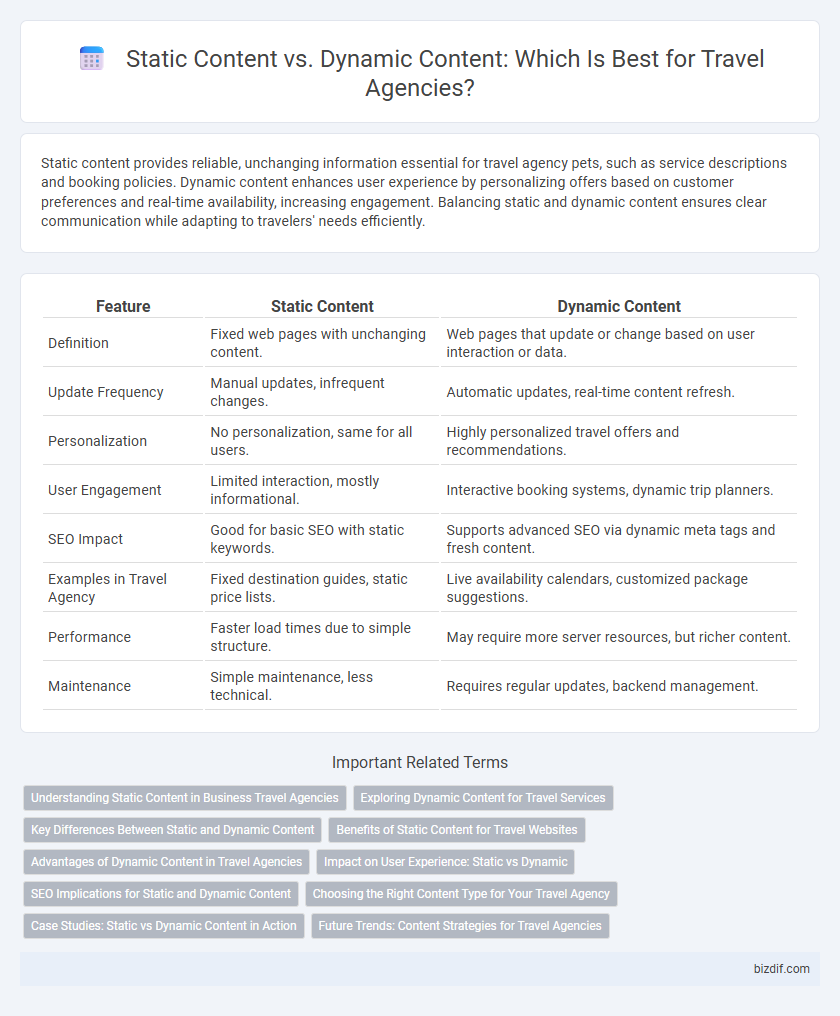Static content provides reliable, unchanging information essential for travel agency pets, such as service descriptions and booking policies. Dynamic content enhances user experience by personalizing offers based on customer preferences and real-time availability, increasing engagement. Balancing static and dynamic content ensures clear communication while adapting to travelers' needs efficiently.
Table of Comparison
| Feature | Static Content | Dynamic Content |
|---|---|---|
| Definition | Fixed web pages with unchanging content. | Web pages that update or change based on user interaction or data. |
| Update Frequency | Manual updates, infrequent changes. | Automatic updates, real-time content refresh. |
| Personalization | No personalization, same for all users. | Highly personalized travel offers and recommendations. |
| User Engagement | Limited interaction, mostly informational. | Interactive booking systems, dynamic trip planners. |
| SEO Impact | Good for basic SEO with static keywords. | Supports advanced SEO via dynamic meta tags and fresh content. |
| Examples in Travel Agency | Fixed destination guides, static price lists. | Live availability calendars, customized package suggestions. |
| Performance | Faster load times due to simple structure. | May require more server resources, but richer content. |
| Maintenance | Simple maintenance, less technical. | Requires regular updates, backend management. |
Understanding Static Content in Business Travel Agencies
Static content in business travel agencies includes fixed information such as company policies, service offerings, and destination guides that remain unchanged over time. This type of content provides consistency and reliability for clients seeking essential travel details and helps build trust through clear, accessible information. By optimizing static content with relevant keywords and structured data, travel agencies can improve search engine visibility and attract potential customers.
Exploring Dynamic Content for Travel Services
Dynamic content in travel services enables real-time updates on flight availability, hotel bookings, and destination guides, enhancing customer engagement and personalization. Unlike static content, dynamic content leverages APIs and user data to provide customized travel itineraries and promotions tailored to individual preferences. This approach significantly improves the responsiveness and relevancy of travel websites, driving higher conversion rates and customer satisfaction.
Key Differences Between Static and Dynamic Content
Static content consists of fixed information delivered to every visitor, such as travel destination descriptions or contact details, requiring manual updates for changes. Dynamic content adapts in real-time based on user interactions, preferences, or database queries, offering personalized travel recommendations or live availability of flights and hotels. This flexibility enhances user engagement and allows travel agencies to provide tailored experiences, improving customer satisfaction and conversion rates.
Benefits of Static Content for Travel Websites
Static content on travel websites offers faster loading times, improving user experience and reducing bounce rates. It provides consistent, reliable information, such as destination guides and booking policies, ensuring travelers access accurate details without delay. Enhanced security and lower server costs make static content a cost-effective solution for travel agencies aiming to maintain high performance and trustworthiness.
Advantages of Dynamic Content in Travel Agencies
Dynamic content in travel agencies enhances user engagement by providing personalized travel recommendations based on real-time data such as user preferences, location, and seasonal offers. It enables seamless updates for flight availability, pricing, and special promotions, ensuring travelers receive accurate and timely information. This adaptability improves conversion rates and customer satisfaction by delivering tailored experiences that static content cannot achieve.
Impact on User Experience: Static vs Dynamic
Static content, such as fixed travel itineraries and destination descriptions, offers fast loading times and consistent information, enhancing reliability for users seeking straightforward details. Dynamic content, including personalized trip recommendations and real-time booking updates, significantly improves user engagement by delivering tailored experiences that adapt to individual preferences and current travel conditions. The balance between static and dynamic content is crucial for travel agencies to provide both stable information and interactive, personalized features that drive customer satisfaction and conversions.
SEO Implications for Static and Dynamic Content
Static content in travel agency websites offers fast loading times and consistent SEO performance by providing fixed, crawlable information like destination guides and service details. Dynamic content, generated based on user interaction or real-time data such as availability and pricing, enhances user experience but may require advanced indexing strategies to ensure search engines properly crawl and rank this content. Balancing static content for stability with dynamic content for personalization maximizes SEO impact and drives higher organic traffic.
Choosing the Right Content Type for Your Travel Agency
Static content provides consistent, easily accessible information about destinations, itineraries, and travel policies, ideal for foundational pages like FAQs and contact details. Dynamic content enhances user engagement by delivering personalized offers, real-time availability, and interactive maps based on user behavior and preferences. Selecting the right content type involves balancing reliability and customization to improve user experience and conversion rates in your travel agency's digital platform.
Case Studies: Static vs Dynamic Content in Action
Case studies reveal that static content, such as fixed travel itineraries and hotel descriptions, offers fast loading times and consistent user experience for travel agency websites. Dynamic content, including personalized travel recommendations and real-time availability updates, enhances customer engagement and conversion rates by delivering tailored information. Travel agencies leveraging a combination of static and dynamic content achieve improved SEO performance and higher customer satisfaction.
Future Trends: Content Strategies for Travel Agencies
Travel agencies must prioritize dynamic content, such as personalized itineraries and real-time availability updates, to enhance user engagement and conversion rates. Future trends emphasize integrating AI-driven recommendations and interactive multimedia, enabling more responsive and tailored customer experiences. Static content remains valuable for foundational information, but dynamic, adaptive content strategies will dominate the travel industry's digital landscape.
Static Content vs Dynamic Content Infographic

 bizdif.com
bizdif.com